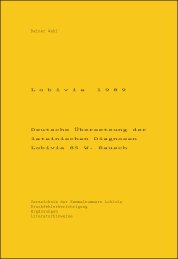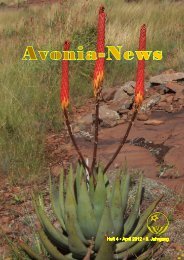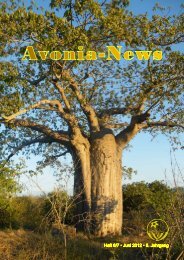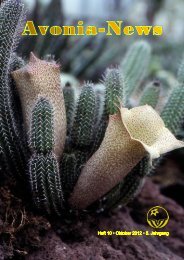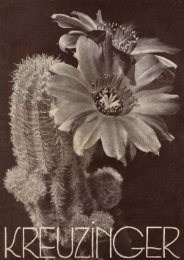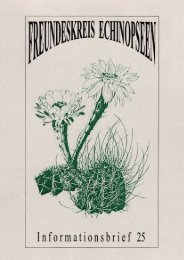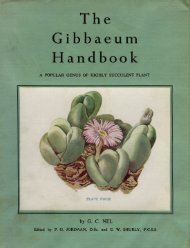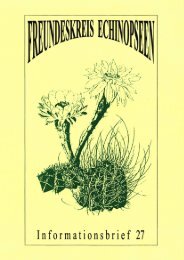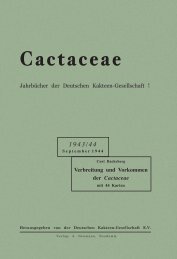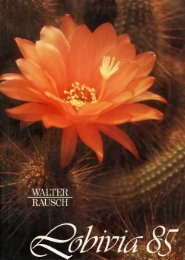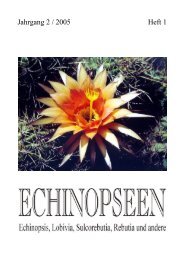Lithops - Au Cactus Francophone
Lithops - Au Cactus Francophone
Lithops - Au Cactus Francophone
You also want an ePaper? Increase the reach of your titles
YUMPU automatically turns print PDFs into web optimized ePapers that Google loves.
ander > an der<br />
tausende ><br />
Tausende<br />
as > als<br />
M. pseudotruncatellum) dunkler Zeichnung. Einschnitt zwischen den beiden<br />
Blättern 8 mm. tief. Cuticula sehr fein gekörnelt. Blütenstiel 3.5 cm. lang,<br />
unterm Fruchtknoten 7 mm. breit, 4 mm. dick, grün. Blüte unter den Kelch<br />
zähnen 10 mm. breitgedruckt, 4–5 mm. dick. Kelchzähne fünf, 5 mm. lang,<br />
an der Basis 3 mm. breit, alle fünf gleich, mit schmalen häutigen Rande ver<br />
sehen, weisslichbraun, deutlich sichtbar dicht punktiert. Korollendurch messer<br />
25 mm. Petalen rein weiss, zweireihig, unten frei ca. 30, verkehrt lanzettlich,<br />
abgerundet, grösste Breite 2 mm. Stamina 6 mm., aufrecht, weiss, mit ei<br />
nem schmalen Ringe kurzer, farbloser Haare nahe ihrer Basis, Antheren hell<br />
gelb. Stigmata fünf, 8 mm. lang, schlank, bis auf den flachen Fruchtknoten<br />
frei, unten grünlich, im oberen Teile gelb aufrecht, dann etwas divergierend<br />
und oben wieder zusammengeneigt.<br />
Grossnamaland: <strong>Au</strong>f Granitgrus in den Bergen von <strong>Au</strong>s und Gubub,<br />
sowie Kuckaus an der Wasserstelle 2 (Kessel), in Blüte Juni 1922.<br />
Die prächtige, mittelgrosse Art, deren man in der Blütezeit in den er<br />
sten Nachmittagstunden Tausende an einem Tage sehen kann, passt sich so<br />
her vorragend gilt an ihr Substrat an, dass ich, während ich (ganz zufällig) auf<br />
einer kleine horizontalen Granitgrusfläche an einem Vormittage nur drei Ex<br />
emplare trotz aller Anstrengungen meiner guten <strong>Au</strong>gen entdecken konnte, auf<br />
der gleichen Stelle am selben Nachmittage zu meiner grossen Überraschung<br />
deren weit mehr als 100 fand.<br />
3. LITHOPS BREVIS<br />
<strong>Lithops</strong> Brevis. (Plate 4.) Growths solitary or forming clumps of two or more;<br />
turbinate; top of lobe flat; window large, open, transparent, very light green,<br />
with a few round, elliptical blood red lines near inner margin or blood red<br />
markings absent; outer margin slightly sinuous or minutely serrate; inner mar<br />
gin straight; window bordered by a buff coloured band, with many minute<br />
dots in the band. Flowers yellow.<br />
Namaqualand: Hill 5 miles S.E. of Viool’s Drift, Orange River.<br />
In the description of this plant L. Bolus states that it is related to<br />
L. olivacea and may be a variety of the latter. To my mind this species, L.<br />
brevis, is definitely related to L. Dinteri, which grows just across the river,<br />
and these two species are not related to L. olivacea. L. Dinteri was exam<br />
ined in the live condition. The main point of difference between L. brevis<br />
and L. Dinteri is that the red spots of the latter are fulgent red, 10–15,<br />
whereas those of L. brevis are fewer in number and dull red and not so<br />
prominent. One need only compare Fig. 18 with Fig. 28 to see in what way<br />
these two species differ from one another. It may, however, on a further study<br />
of these two species appear that they are identical and in that case L. brevis<br />
would have to disappear.<br />
57<br />
hellbelb > hellgelb



